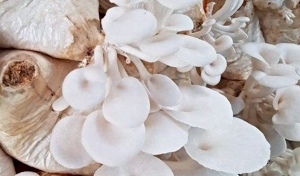 Oyster mushroom (Pleurotus ostereatus), one of the common edible mushroom here in the Philippines. It is frequently used in some Japanese, Korean and Chinese dishes. Aside from Asian dishes, Oyster mushrooms were became popular in the country for its new recipe, the Fried oyster mushroom which tastes crispy outside and soft inside.
Oyster mushroom (Pleurotus ostereatus), one of the common edible mushroom here in the Philippines. It is frequently used in some Japanese, Korean and Chinese dishes. Aside from Asian dishes, Oyster mushrooms were became popular in the country for its new recipe, the Fried oyster mushroom which tastes crispy outside and soft inside.
Named for its shell-like appearance and resemblance to oysters, Oyster mushroom has a mild flavor and Licorice-like aroma. It is packed with antioxidants, boost brain health, lowest cholesterol levels, improve immune function, fight cancer tumors and has antibacterial effects.
Oyster Mushroom Production
GRAIN SPAWN PREPARATION
The basic material in grain spawn is sorghum or any cereal seeds. Wash grains thoroughly and discard all floated seeds. Boil for at least 20-25 minutes. Collect seeds using strainer to drain the water and spread out on newspaper or manila paper to absorb the excess water. Transfer the boiled grains in round bottle (e.g catsup or Gatorade), plug with cotton waste and cover with clean paper. Sterilize the bottled grains at 15 psi for one hour. Cool down. When cooled, pure culture stubs of chosen mushroom specie will be inoculated in the sterilized bottled grains. Incubate for 14 days. This serves as grain spawn. Use the grain spawn to inoculate sterilized fruiting bags.
PREPARATION OF SUBSTRATES AND FRUITING BAGS
A. Mixing and Fermentation of Substrate Materials
Formulations is based on General recommendation. Combine rice bran (20%) sugar or molasses (1%), lime (1%), to sawdust (78%). Moisten and pile into heap (moisture content is about 60%). Cover with plastic sheets and turn evenly the heap materials every 2-3 days for 15-21 days. However, if old sawdust and stored under open space is to be used, fermentation is no longer needed.
B. Filling the Bags
Use plastic bags of 6×12 inches polypropylene plastic (PP) bags size 0.2 or 0.3 mm. Fill 1 kg of fermented substrate materials in the pp bags and then compress. Then put pvc pipe neck (1 inch diameter), plug with cotton waste, cover with clean paper or plastic cap to minimize entry of water during steaming or pasteurization.
C. Pasteurization or Steaming
Steam the bags in a pasteurizer like drum for 6- 8 hours and cool down. Provide drums with cover that fits tightly on top. Provide racks to hold the bags inside the drum.
Another method is sterilizing the bags in an autoclave or pressure cooker for 1 and 1/2 hours at 15 psi.
D. Inoculating the Bags
Inoculate each bag with the grain spawn in a clean and aseptic place. To inoculate, shake the grain spawn bottle to loosen the grains, remove the plug and flame the mouth of the bottle and pour some grains into the bags. Slightly shake the neck area of newly inoculated bags to distribute evenly the grains in the shoulder area of the bags.
E. Incubation
Keep the spawned bags in a dry and ventilated room for at least 30-45 days. If within five days of incubation and no growth appears, the spawn is dead or the substrate is too dry. The bag could be contaminated with other microorganisms. Mycelium will fill the bags in 20-30 days, which means the bags are ready to fruit initiation.
Open the bags 1-2 weeks after the bag is totally covered with mycelium. This is to make sure that the mycelium is matured enough to fruit. Inoculated bags could be pile and incubate directly in a growing house provided the house will remain dry to obtain the required incubation time.
F. Fruiting and Its Requirement
Fruiting requires a temperature not more than 28°C, ventilation, light, and relative humidity (80 – 85%). Provide moisture by watering the mushroom house daily. Do not water directly on bags’ opening. To lower the temperature and hasten fruiting, spray the house frequently if the temperature is more than 28°. Provide air ventilation at lower and upper part of walls but secured with insect net to prevent entry of insects.
For more information, please visit or call:
Bureau of Plant Industry – Crop Research Production
Support Division – Mushroom Culture Laboratory
692 San Andres Street Malate, Manila, Philippines
Phone: (02) 525-74-03
Fax: (02) 521-76-50
Mobile: (0919)991-3360
E-mail: [email protected]
or [email protected]
Acknowledgement: Mary Ann B. Guerrero; Julie Ann A. Aragones;Hazel Joy A. Nono; Mark Jay A. Nono; Vivencio R. Mamaril, Ph.D; Lina C. Lapitan Florencio C. Abarquez; Anita Perido
Source: www.bpi.da.gov.ph / Photo: www.entrepreneur.com.ph